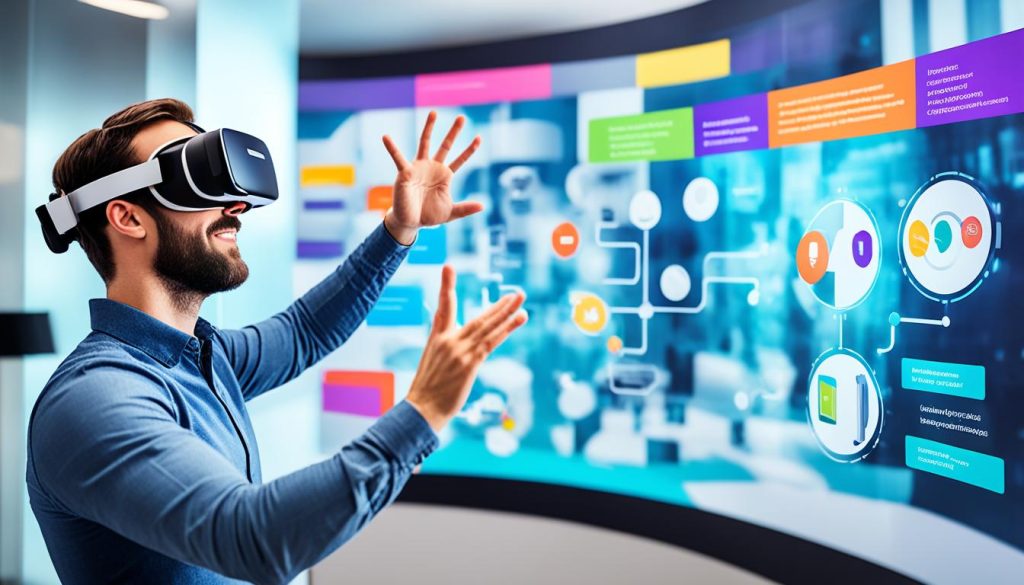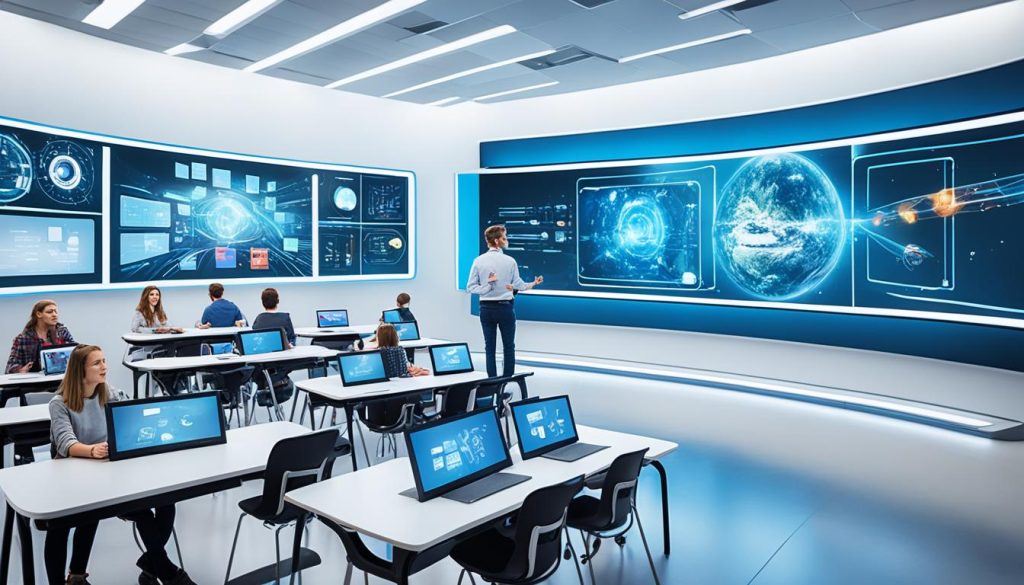E-learning development companies are at the forefront of driving innovation in the digital education industry. These companies specialize in creating e-learning solutions and content, utilizing cutting-edge technology like augmented reality and artificial intelligence. With a culture of continuous learning and the use of digital learning programs, e-learning development firms are fostering creativity, keeping employees updated with fresh skills, and meeting the demands of modern customers.
Key Takeaways:
- E-learning development companies are driving innovation in the digital education industry.
- They specialize in creating e-learning solutions and content.
- Advanced technologies like augmented reality and artificial intelligence are utilized in their offerings.
- Culture of continuous learning and digital learning programs are key elements.
- E-learning development firms meet the demands of modern customers.
The Role of Digital Learning in Fostering Innovation
Digital learning plays a crucial role in fostering innovation within organizations. By promoting a culture of continuous learning, employees are encouraged to have frequent creative ideas and share them with others. Digital learning programs provide access to a wealth of knowledge and skills, ensuring employees are updated with the latest industry trends. This continuous learning effort is driven by the Learning and Development (L&D) teams within e-learning development companies.
When organizations embrace a culture of continuous learning, they create an environment where employees are motivated to expand their knowledge and explore new ideas. Through digital learning programs, employees have the opportunity to engage in self-paced learning, allowing them to acquire new skills at their own convenience. This flexibility enables them to stay updated with the latest industry trends, best practices, and innovative approaches.
Moreover, digital learning programs enable employees to access a diverse range of learning resources, including online courses, webinars, interactive modules, and collaborative platforms. These resources provide a rich learning experience that combines theory and practical application, fostering innovative thinking. By encouraging employees to leverage these resources, organizations promote a culture of continuous learning that serves as a catalyst for innovation.
“Digital learning programs provide employees with the tools and resources they need to continuously upskill and stay relevant in today’s rapidly evolving digital landscape.”
Learning and Development (L&D) teams within e-learning development companies play a key role in driving this culture of continuous learning. These teams design and curate digital learning programs that align with the organization’s goals and meet the evolving needs of employees. By leveraging learning management systems, e-learning content, and multimedia resources, L&D teams ensure that digital learning programs are engaging, interactive, and accessible to all employees.
With the guidance and support of L&D teams, employees can take ownership of their learning journey and actively participate in their professional development. This self-directed learning approach empowers individuals to explore new areas of interest, acquire new skills, and pursue innovative solutions to challenges they encounter in their work.
Overall, digital learning programs and the culture of continuous learning they foster contribute significantly to organizational innovation. By equipping employees with the knowledge, skills, and mindset necessary to adapt and innovate, organizations can stay ahead of the curve and drive meaningful progress in the digital age.
Embracing Technological Advances in L&D
Leading e-learning development companies have embraced technological advances to enhance their Learning and Development (L&D) programs. These companies recognize the potential of augmented reality (AR), virtual reality (VR), and artificial intelligence (AI) in revolutionizing digital education.
AR and VR technologies offer immersive learning experiences, creating a virtual environment where learners can engage with content in a more interactive and realistic manner. By incorporating AR and VR into their educational programs, e-learning development companies augment the learning process, facilitating better absorption and long-term retention of information.

Acquiring Knowledge through Immersive Experiences
With augmented reality, learners can visualize complex concepts in a 3D environment, allowing for a deeper understanding of abstract ideas. For example, medical students can use AR to explore virtual anatomy models, enhancing their grasp of human anatomy before interacting with real patients.
Virtual reality, on the other hand, provides a simulated environment that replicates the real world or creates fictional scenarios for learning purposes. Learners can gain hands-on experience in various settings without any physical limitations. For instance, flight simulator programs allow aspiring pilots to practice without risks, building their skills and confidence in a safe virtual environment.
Personalized Guidance and Support through Artificial Intelligence
Artificial intelligence plays a crucial role in modern L&D programs by providing personalized guidance and support to learners. AI algorithms analyze individual learners’ progress, behavior, and preferences to deliver tailored learning experiences. Learners receive real-time feedback, customized recommendations, and adaptive learning paths, optimizing their learning journey.
AI-powered chatbots and virtual assistants can also answer learners’ questions and provide immediate support, enabling self-paced learning and ensuring learners have access to assistance whenever needed. This technology’s efficiency in addressing learner needs enhances the overall learning experience and fosters a supportive and interactive learning environment.
Early Adoption of Digital Learning Drives Technological Integration
The successful implementation of AR, VR, and AI in e-learning development companies’ L&D programs is primarily due to their early adoption of digital learning. By embracing digital learning platforms and tools, these companies were well-positioned to integrate advanced technologies into their educational practices.
This early adoption allowed e-learning development companies to explore the potential of emerging L&D technologies and identify their benefits for both learners and organizations. With a strong foundation in digital learning, these companies can navigate the integration process smoothly and capitalize on the opportunities presented by augmented reality, virtual reality, and artificial intelligence in enhancing learning outcomes.
Benefits of Technological Advances in L&D
| Technology | Benefits |
|---|---|
| Augmented Reality (AR) |
|
| Virtual Reality (VR) |
|
| Artificial Intelligence (AI) |
|
The integration of augmented reality, virtual reality, and artificial intelligence into Learning and Development programs is transforming the educational landscape. E-learning development companies that embrace these technological advances offer learners innovative and engaging experiences, ultimately shaping the future of digital education.
Meeting Customer Demands in the Digital Age
In today’s digital age, customers have high expectations for convenient and digitally accessible products and services. This shift in consumer behavior has elevated the need for businesses to adapt and meet these demands effectively. For e-learning development companies, this means not only providing innovative digital learning solutions but also ensuring their own employees are well-versed in digital learning strategies and technologies.
By prioritizing digital learning within their organizations, these companies can equip their employees with the necessary skills and knowledge to fulfill customer demands in the digital sphere. Digital learning programs enable employees to enhance their capabilities and stay updated with the latest trends and advancements in their respective fields. This empowers them to create and deliver exceptional digital learning experiences that meet the evolving needs of customers.
By utilizing digital learning methodologies in their own operations, e-learning development companies set a powerful example for their customers and demonstrate their commitment to delivering cutting-edge solutions.
Through digital learning, employees can gain proficiency in creating and delivering online courses, utilizing interactive learning platforms, and leveraging various digital tools for content creation and dissemination. This expertise enables them to develop and offer a wide range of digital learning products and services that cater to the diverse needs and preferences of customers.
By offering a comprehensive suite of digital learning offerings, e-learning development companies position themselves as leaders in the industry and attract customers who are seeking comprehensive and user-friendly solutions to meet their learning needs.
Employing digital learning strategies not only allows e-learning development companies to meet customer demands but also provides them with a distinct competitive edge in the market.
The Benefits of Digital Learning for Customers:
- Convenience: Customers can access learning materials anytime, anywhere, using their preferred device.
- Flexibility: Digital learning allows customers to learn at their own pace and customize their learning experience according to their specific needs.
- Engagement: Interactive and multimedia-rich digital learning experiences captivate and engage learners, enhancing knowledge retention.
- Personalization: Digital learning platforms can provide personalized learning paths and recommendations based on individual learning preferences and goals.
- Accessibility: Digital learning eliminates barriers to education by providing inclusive learning experiences for individuals with diverse abilities.
“Digital learning enables us to meet our customers’ demands by providing them with convenient and personalized learning experiences that fit their busy lifestyles. By harnessing the power of digital technologies, we are revolutionizing education and empowering learners around the world.”

Advantages of Digital Learning for Customers
| Benefits | Description |
|---|---|
| Convenience | Customers can access learning materials anytime, anywhere, using their preferred device. |
| Flexibility | Customers can learn at their own pace and customize their learning experience according to their specific needs. |
| Engagement | Interactive and multimedia-rich digital learning experiences enhance knowledge retention. |
| Personalization | Platforms can provide personalized learning paths and recommendations based on individual learning preferences and goals. |
| Accessibility | Digital learning eliminates barriers to education by providing inclusive learning experiences for individuals with diverse abilities. |
Learning and Development as an Innovation Catalyst
Learning and Development (L&D) teams play a pivotal role in fueling innovation within organizations. By leveraging learning technologies and fostering innovation capabilities, these teams contribute to the growth and success of companies.
Leveraging Learning Technologies: L&D teams that experiment with cutting-edge learning technologies promote a culture of continuous improvement and innovation. By embracing new tools and platforms, organizations can offer engaging and interactive learning experiences that drive creativity and enhance knowledge retention.
Innovation Capabilities: The ability to innovate is a critical skill in the modern business landscape. L&D teams facilitate this by building in-the-flow learning strategies, fostering agility, and aligning business leaders with the organization’s learning objectives. Additionally, honing analytics and tech skills enables organizations to leverage data-driven insights, identify emerging trends, and fuel innovation.
“Learning and Development teams are at the forefront of driving innovation within organizations. By capitalizing on learning technologies and cultivating innovation capabilities, these teams empower employees to think critically, embrace change, and drive business growth.”
By empowering employees with the right learning tools and fostering an environment that supports innovation, organizations can unlock their full potential and stay ahead in today’s rapidly evolving business landscape. Embracing learning technologies and investing in continuous learning ensures that companies not only adapt to change but also drive innovative solutions that shape the future.
Enhancing Innovation with Learning Technologies
Learning technologies offer numerous opportunities for organizations to drive innovation. Here are a few ways in which they can be leveraged:
- Augmented Reality (AR) and Virtual Reality (VR): AR and VR technologies provide immersive learning experiences, enabling employees to explore and experiment in simulated environments. This fosters creativity and problem-solving skills, driving innovation in various areas of the organization.
- Mobile Learning: With the ubiquitous presence of smartphones and tablets, organizations can leverage mobile learning platforms to provide on-the-go access to training and development resources. This enables employees to learn anytime, anywhere, enhancing innovation capabilities.
- Personalized Learning: Learning technologies allow organizations to deliver customized training programs tailored to each employee’s individual needs. Personalized learning pathways help discover hidden talents, nurtures strengths, and empowers employees to think innovatively.
Investing in learning technologies and providing employees with the necessary resources and support demonstrates a commitment to fostering innovation. By continuously evolving and adapting to new technologies, organizations can create an environment that inspires creativity and drives breakthrough solutions.

How L&D Teams Drive Business Innovation
Learning and Development (L&D) teams play a crucial role in driving business innovation. They are responsible for creating a workplace culture that supports creativity and continuous learning. By fostering an environment that encourages employees to think critically and engage in design thinking, L&D teams facilitate the development of key skills needed for innovation to thrive.
One way L&D teams drive business innovation is by providing opportunities for employees to experiment with technology. This hands-on experience allows employees to explore new tools and platforms, fostering a mindset of innovation and adaptability. By encouraging employees to take risks and try new approaches, L&D teams enable the organization to stay at the forefront of industry advancements.
Additionally, L&D teams play a crucial role in developing leadership capabilities within the organization. Through targeted training programs, they equip managers and executives with the skills necessary to lead and inspire innovation. By nurturing a culture of leadership that values collaboration and fosters creativity, L&D teams empower leaders to drive change and embrace new ideas.
Enhancing the Knowledge Network
Another way L&D teams drive business innovation is by expanding and strengthening the knowledge network within organizations. By facilitating knowledge sharing and collaboration, L&D teams ensure that employees have access to a wide range of expertise and perspectives. This cross-pollination of ideas enables innovative solutions to emerge and helps overcome challenges that may arise during the innovation process.
“L&D teams play a crucial role in driving business innovation by fostering critical thinking, promoting design thinking, enhancing leadership capabilities, and expanding the knowledge network.”
Moreover, L&D teams contribute to business innovation by fostering critical thinking and problem-solving skills among employees. Through targeted training and development programs, they equip employees with the necessary tools and techniques to analyze complex problems, think innovatively, and propose creative solutions. By building a workforce that excels in critical thinking, L&D teams enable the organization to tackle challenges with agility and creativity.
To summarize, L&D teams drive business innovation by creating a workplace culture that supports creativity and continuous learning, facilitating critical thinking and problem-solving skills, providing opportunities for employees to experiment with technology, developing design thinking abilities, enhancing leadership and management capabilities, and expanding and strengthening the knowledge network within organizations.

Through their efforts, L&D teams play a vital role in shaping the future of business innovation and driving organizations towards success in the dynamic and rapidly evolving business landscape.
Conclusion
E-learning development companies are revolutionizing the field of digital education. As leading e-learning solution providers, these companies have embraced digital learning, fostering a culture of continuous learning and utilizing cutting-edge technology. By prioritizing creativity, skills development, and meeting customer demands, these e-learning software companies are shaping the future of education.
Through the use of digital learning programs, e-learning development companies ensure that employees have access to the latest industry trends and knowledge. By leveraging augmented reality, artificial intelligence, and other innovative technologies, they provide immersive learning experiences and personalized guidance. This commitment to embracing technological advances sets these companies apart in the digital education landscape.
With a focus on meeting customer demands for convenient and digitally accessible products and services, e-learning development companies are propelling organizations toward the future. By training their employees in the digital sphere, they empower businesses to deliver high-quality digital learning experiences, keeping pace with the evolving needs of customers.




No comments! Be the first commenter?